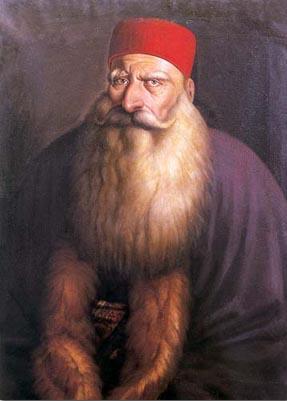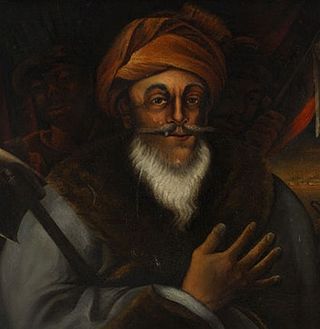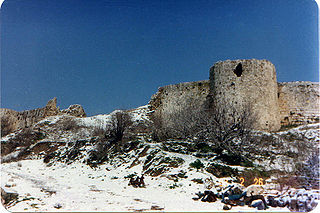Zahir al-Umar al-Zaydani, alternatively spelled Daher al-Omar or Dahir al-Umar, was an Arab ruler of northern Palestine in the mid-18th century, while the region was part of the Ottoman Empire. For much of his reign, starting in the 1730s, his domain mainly consisted of the Galilee, with successive headquarters in Tiberias, Deir Hanna and finally Acre, in 1750. He fortified Acre, and the city became the center of the cotton trade between Palestine and Europe. In the mid-1760s, he reestablished the port town of Haifa nearby.

The Eyalet of Sidon was an eyalet of the Ottoman Empire. In the 19th century, the eyalet extended from the border with Egypt to the Bay of Kisrawan, including parts of modern Israel and Lebanon.

Bashir Shihab II was a Lebanese emir who ruled the Emirate of Mount Lebanon in the first half of the 19th century. Born to a branch of the Shihab family which had converted from Sunni Islam, the religion of previous Shihabi emirs, he was the only Maronite ruler of the Mount Lebanon Emirate.

Ahmed Pasha al-Jazzar was the Acre-based Ottoman governor of Sidon Eyalet from 1776 until his death in 1804 and the simultaneous governor of Damascus Eyalet in 1785–1786, 1790–1795, 1798–1799, and 1803–1804. Having left his native Bosnia as a youth, he began a military career in Egypt in the service of mamluk officials, eventually becoming a chief enforcer and assassin for Ali Bey al-Kabir, Egypt's practical ruler. He gained the epithet of al-Jazzar for his deadly ambush on a group of Bedouin tribesmen in retaliation for the death of his first master in a Bedouin raid. Al-Jazzar fell out with Ali Bey in 1768 after refusing to take part in the assassination of another of his former masters. He ultimately fled to Syria, where he was tasked by the Ottomans with defending Beirut from a joint assault by the Russian Navy and Zahir al-Umar, the Acre-based ruler of northern Palestine. He eventually surrendered and entered Zahir's service before defecting from him and fleeing with stolen tax money.

The Shihab dynasty is an Arab family whose members served as the paramount tax farmers and local chiefs of Mount Lebanon from the early 18th to mid-19th century, during Ottoman rule. Their reign began in 1697 after the death of the last Ma'nid chief. The family centralized control over Mount Lebanon, destroying the feudal power of the mostly Druze lords and cultivating the Maronite clergy as an alternative power base of the emirate. The Shihab family allied with Muhammad Ali of Egypt during his occupation of Syria, but was deposed in 1840 when the Egyptians were driven out by an Ottoman-European alliance, leading soon after to the dissolution of the Shihab emirate. Despite losing territorial control, the family remains influential in modern Lebanon, with some members having reached high political office.

The Ma'n dynasty, also known as the Ma'nids;, were a family of Druze chiefs of Arab stock based in the rugged Chouf area of southern Mount Lebanon who were politically prominent in the 15th–17th centuries. Traditional Lebanese histories date the family's arrival in the Chouf to the 12th century, when they were held to have struggled against the Crusader lords of Beirut and of Sidon alongside their Druze allies, the Tanukh Buhturids. They may have been part of a wider movement by the Muslim rulers of Damascus to settle militarized Arab tribesmen in Mount Lebanon as a buffer against the Crusader strongholds along the Levantine coast. Fakhr al-Din I, the first member of the family whose historicity is certain, was the "emir of the Chouf", according to contemporary sources and, despite the non-use of mosques by the Druze, founded the Fakhreddine Mosque in the family's stronghold of Deir al-Qamar.

The Ottoman Empire nominally ruled Mount Lebanon from its conquest in 1516 until the end of World War I in 1918.
Sulayman Pasha al-Azm was the governor of Sidon Eyalet (1727–33), Damascus Eyalet, and Egypt Eyalet (1739–40) under the Ottoman Empire. He belonged to the prominent Al-Azm family and was the uncle of As'ad Pasha al-Azm, who succeeded him as governor of Damascus, and Sa'deddin Pasha al-Azm, who also served as governor of Egypt.
Uthman Pasha al-Kurji, was the Ottoman governor (wali) of Damascus Eyalet between 1760 and 1771.
Al-Zayadina were an Arab clan based in the Galilee. They were best known after one of their sheikhs (chiefs) Zahir al-Umar, who, through his tax farms, economic monopolies, popular support, and military strength ruled a semi-autonomous sheikhdom in northern Palestine and adjacent regions in the 18th century.
Nasif ibn al-Nassar al-Wa'ili was the most powerful sheikh of the rural Shia Muslim (Matawilah) tribes of Jabal Amil in the mid-18th century. He was based in the town of Tebnine and was head of the Ali al-Saghir clan. Under his leadership, the Jabal Amil prospered, due largely to the revenues from dyed cotton cloth exports to European merchants.
Yusuf Shihab (1748–1790) was the autonomous emir of Mount Lebanon between 1770 and 1789. He was the fifth consecutive member of the Shihab dynasty to govern Mount Lebanon.

Safed Sanjak was a sanjak (district) of Damascus Eyalet in 1517–1660, after which it became part of the Sidon Eyalet. The sanjak was centered in Safed and spanned the Galilee, Jabal Amil and the coastal cities of Acre and Tyre. The city of Safed was made up of Muslim and Jewish townspeople, while the rest of the sanjak was populated by Sunni Muslims, Jewish peasants, Bedouin tribesmen, Shia Muslims/Mitwali, and Druze peasants.
Abdullah Pasha ibn Ali was the Ottoman governor (wali) of Sidon Eyalet between May 1820 and May 1832, with a nine-month interruption in 1822–23. Like his predecessors Jazzar Pasha and Sulayman Pasha, Abdullah Pasha ruled from the port city of Acre. During his reign, all of Palestine and the Syrian coastline came under his jurisdiction. Among his major military victories was his survival of an imperial-backed siege of Acre in 1822 instigated by the Farhi family in retaliation for Abdullah's execution of his mentor Haim Farhi, the suppression of revolts in Mount Lebanon and Jerusalem in 1824 and 1826, respectively, and the 1831 capture of the Sanur fortress.
Mansur Shihab was the Emir of Mount Lebanon between 1754 and 1770. He and his brother Ahmad took the reins of power from their ailing brother Mulhim Shihab and ruled jointly until Mansur became the sole emir after winning a power struggle with Ahmad in 1763. Mansur aligned himself with Zahir al-Umar and Ali Bey, the autonomous rulers of Galilee and Egypt, respectively, in their rebellion against the Ottomans. Mansur was subsequently forced by the Druze sheikhs of Mount Lebanon to step down in favor his nephew Yusuf Shihab after Zahir and Ali Bey were defeated in 1770.
Darwish Pasha al-Kurji was an Ottoman statesman who served as wali (governor) of Sidon in 1770–1771 and Damascus in 1783–1784. He was the son of Uthman Pasha al-Kurji, who was of Georgian origin.
Arslan Mehmed Mataraci Pasha, also Arslan Muhammad Pasha ibn al-Mataraji, was the wali of Tripoli in 1694–1700 and 1702–1703, Damascus in 1701 and Sidon in 1703–1704.

El-Assaad or Al As'ad is an Arab feudal political family/clan originally from Najd and a main branch of the Anizah tribe. Unrelated to Syrian or Palestinian Al-Assads, El-Assaad dynasty that ruled most of South Lebanon for three centuries and whose lineage defended fellow denizens of history's Jabal Amel principality – today southern Lebanon – for 36 generations, Balqa in Jordan, Nablus in Palestine, and Homs in Syria governed by Ottoman rule between generations throughout the Arab caliphate by Sheikh al Mashayekh Nasif Al-Nassar ibn Al-Waeli, Ottoman conquest under Shbib Pasha El Assaad, Ali Bek El Assaad ruler of Belad Bechara, Ali Nassrat Bek. Advisor of the Court and a Superior in the Ministry of Foreign affairs in the Ottoman Empire, Moustafa Nassar Bek El Assaad Supreme Court President of Lebanon and colonial French administration by Hassib Bek—also supreme court Judge and grand speaker at halls across the Levant. El-Assaads are considered now "Bakaweit", and are considered princes or heirs to the family's dynasty to some.

Sidon is one of the oldest inhabited cities in the world and has a rich and diverse history that spans over 6,000 years. The city's name has changed over time and has been known by various names, including Sidun, Saida, and Saïd. The earliest evidence of human settlement in the area dates back to the Neolithic period, around 4000 BCE. Sidon rose to prominence during the Bronze Age and became one of the most important city-states in the region. It was a major center for trade and commerce and played a significant role in the Mediterranean trade network. The city's strategic coastal location made it a hub for maritime activities.

The Chouf region, also spelled Shouf, is a historical and geographical area located in the central part of Lebanon. Like much of Lebanon, the Chouf was inhabited by the Phoenicians, an ancient Semitic civilization known for their seafaring skills and trade. However, Evidence of inhabitance in the mountains dates back to the 5th century B.C.E. and archaeological evidence, consisting of Roman burial sites and pottery has proved a continuous inhabitation since 450 B.C.E.









